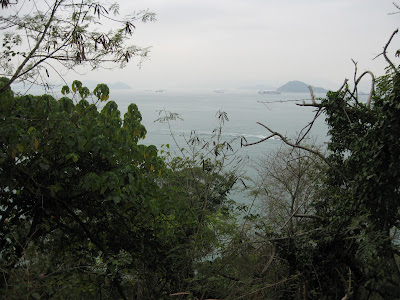About 20 minutes into the walk this was the view. You can just barely make out a few ships lingering near the horizon. Hong Kong is one of the world's busiest container ports and most of the container ships pass through this channel. In colonial times, because this was a strategic location for monitoring all the vessels entering or leaving the west side of Victoria Harbor, about 100 years ago the British installed artillery not far from here to fend off rivals. The Japanese destroyed much of it during WWII. We didn't hike up far enough to see the remnants, but supposedly you can freely explore them.
Looking down the hill under some of these trees we spotted what looked like the remainders of walls and tiled floors. After I got home I read that these are leftovers from squatters' settlements, which sprung up all over Hong Kong in the early 1950's as people fled mainland China.
We heard lots of birds singing today all along these forested areas, and the air smelled like vegetation and salt water. What a welcome relief from the constant low roar of traffic and the smell of exhaust (and occasional frying food) where we live.
Snow-covered mountain in Hong Kong? No, it's a freshly paved hillside on the Mt. Davis Path. You see these hills covered with a layer of concrete all over Hong Kong Island. "Slope maintenance" is a big deal here--you see little metal tags posted every so often with a slope registration number. There are over 50,000 engineered slopes like this, with paving, channels for water, and fences and gates limiting access, all of which has to be maintained in order to insure stability of Hong Kong's steep hills. Looking closely at this hillside you can see the water channel at the side of the road and the drainage pipe outlets dotting the concrete.
This was the view looking out from the reservoir. The mountain in the background is High West. It's right next to the famous Victoria Peak. There's a trail going to the top, accessed on the side opposite this view, which would be another fun trek someday. It's hard to make out in this photo, but there are a couple cemeteries down at the bottom of all of these hills. One is a private Eurasian cemetery from the late 1800's, for the rare Hong Kongers who intermarried with Westerners at that time. They weren't accepted into either the colonial Western cemeteries or the Chinese cemeteries. However, then, as now, a number of those Eurasians who were familiar with both Western and Chinese culture and language were prominent members of the community.




Kathy,
ReplyDeleteI just caught up with your interesting blog. Sounds as if you're thriving. As a prairie boy I could relate to your thoughts about the proximity of so many people. English as a common language really helps doesn't it?
Miss you in MN.
al